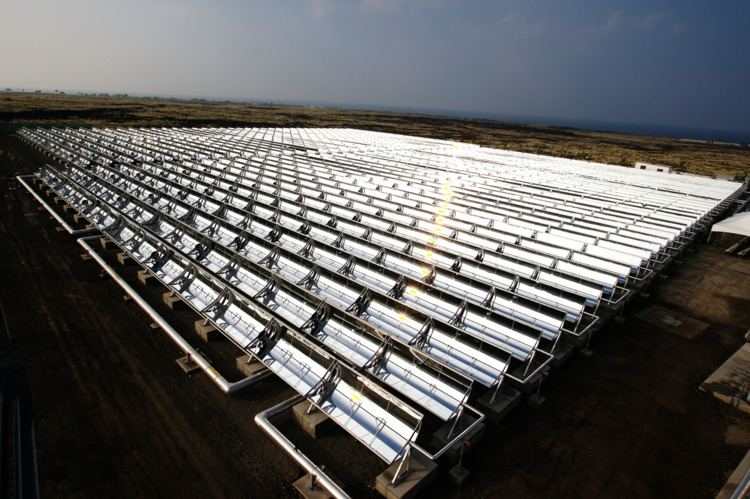 | ||
Hawaii has rapidly adopted solar power due to the high costs of electricity and has one of the highest per capita rates of solar power in the United States. Hawaii's imported energy costs are three times higher, and will soon be close to four times higher than the mainland, so Hawaii has motivation to become one of the highest users of solar energy. Hawaii was the first state in the United States to reach grid parity for photovoltaics. Its tropical location provides abundant sun energy.
Contents
- History
- Kauai
- Solar power energy statistics
- Major solar installations in Hawaii
- Projects under development
- Canceled projects
- References
Much of Hawaii's solar capacity is distributed solar panels on individual homes and businesses. Hawaii's grid has had to deal with this unique situation by developing new technology for balancing the energy flows in areas with large amounts of solar power. In December 2016, Hawaii had 674MW of installed distributed solar capacity. The largest utility-scale solar farm in Hawaii is the 27.6MW EE Waianae Solar Project which opened in January 2017.
History
Hawaii has a renewable portfolio standard of 40% renewable energy by 2030 and 100% by 2045. Hawaii had almost 200 MW of grid-connected photovoltaics in 2012. 16 MW of PV were installed in 2010, 40 MW in 2011, and 109 MW in 2012.
The electrical grids of the Hawaiian islands are each separate and relatively small. "Overbuilding" distributed solar in some areas has led to issues such as partial duck curve, although time-of-use pricing has reduced disadvantages. HECO has made connecting to the grid more difficult, leading to layoffs among the solar installation industry. In 2014, there were over 40,000 rooftop systems, over 10 percent of customers. A proposed grid interconnection between Oahu and Maui would have allowed more renewable energy but was rejected as too costly.
Kauai
Kauai has rapidly adopted solar. In 2009, oil provided 91% of the island's electricity. In 2015, solar provided 15% with other renewables providing another 22% with oil providing 63%. Diesel usage was expected to be reduced by 10 million gallons in 2016 compared to 2008. On some days in 2016, solar power provided 77% of the electricity generation on Kauai.
The largest solar project in Hawaii, the 12MW Anahola project, opened on November 2, 2015 on Kauai. It has 59,000 panels on 60 acres of land and is expected to supply up to 20% of the island's momentary electricity demand and up to 5% of the annual demand. The Anahola project also incorporates a 6MW lithium-ion battery. The 12 MW Kapaia solar plant is connected to a 13 MW / 52 MWh battery, and the power is priced at 13.9 c/kWh. A 2018 project for 28 MW solar with 20 MW / 100 MWh batteries is priced at 11 c/kWh.
Solar power energy statistics
In 2012 a typical solar system in Hawaii paid for itself in only 4 years, and returned a profit of over 4 times the cost over its life. Hawaii's 35% ($5000.00 Maximum) state tax credit is the second highest in the country, behind Louisiana. Hawaii offers a feed-in tariff, but it does not meet the normal definition of a feed-in tariff, as it is less than the retail cost of electricity, and is therefore simply a Power Purchase Agreement. The Oahu Wind Integration Study released a report detailing the impact on the Oahu grid and found that 500 MW of wind and 100 MW of solar power could provide Oahu up to 25% of its electricity while eliminating the need to burn approximately 2.8 million barrels of low sulfur fuel oil and 132,000 tons of coal each year.
In 2010 Hawaii generated 56 GWh of energy by photovoltaics, and 559 GWh in 2014.
This was 0.07% of the state's total electricity generation for 2007, 0.13% for 2008, 0.33% for 2009, 0.51% for 2010, and 1% in 2011. In 2015 solar provided 6% of Hawaii's electricity.
Major solar installations in Hawaii
Projects under development
Canceled projects
Source:
